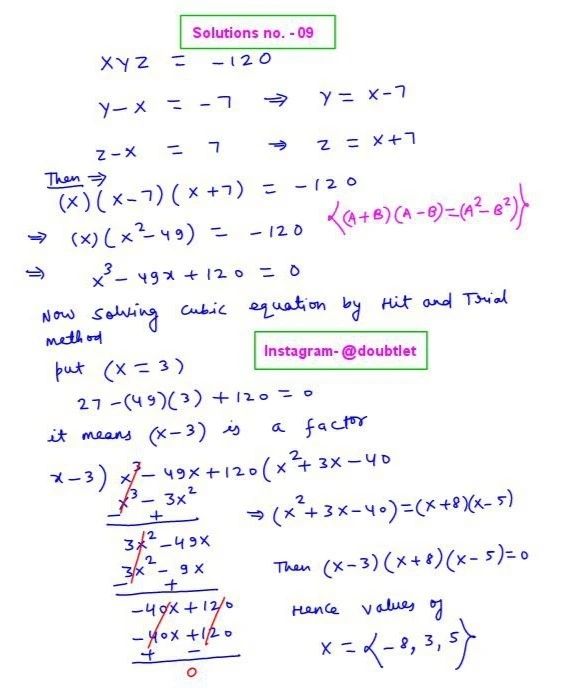









Mastering Matrix Inverses: Techniques, Applications, and Examples
Dive into our detailed guide on matrix inverses! Discover key concepts, step-by-step calculation methods, and practical applications in linear algebra. Ideal for learners and professionals seeking to enhance their understanding of matrix operations.The matrix inverse is a key concept in linear algebra where a square matrix, when multiplied by its inverse, results in the identity matrix. Only non-singular matrices, which have a non-zero determinant, have an inverse. Matrix inverses are essential in solving systems of linear equations and various transformations in engineering and computer science.

Neetesh Kumar | September 13, 2024
Share this Page on:
![]()
![]()
![]()
![]()
![]()
- 1. Introduction to the Matrix Inverse
- 2. What is Matrix Inverse
- 3. How to find the Matrix Inverse
- 4. Rules for Matrix Inverse
- 5. Properties of Matrix Inverse
- 6. Matrix Inverse Solved Examples
- 7. Practice questions on Matrix Inverse
- 8. FAQs on Matrix Inverse
- 9. Real-life application of Matrix Inverse
- 10. Conclusion
1. Introduction to the Matrix Inverse:
In linear algebra , matrices are powerful tools used in a variety of applications, from computer graphics to solving systems of linear equations. One crucial concept within this matrix framework is the Matrix Inverse. The matrix inverse, akin to reversing an operation, plays a vital role in many mathematical computations. In this guide, we will explore the fundamentals of the matrix inverse, how to compute it, and its wide-reaching applications.
2. What is Matrix Inverse:
The matrix inverse is similar to the inverse of a number. Just as multiplying a number by its inverse results in
multiplying a matrix by its inverse yields the identity matrix. If 𝐴 is a square matrix, its inverse satisfies:
Where 𝐼 is the identity matrix (a matrix with ones on the diagonal and zeros elsewhere). However, not all matrices have an inverse. Only non-singular matrices, those with a non-zero determinant, have an inverse.
3. How to Find the Matrix Inverse:
Finding the inverse of a matrix involves a systematic process. Let’s break down the steps:
-
Step 1: Calculate the determinant of the matrix. A matrix must have a non-zero determinant to be invertible. If the determinant is zero, the matrix does not have an inverse.
-
Step 2: Find the cofactor matrix . Compute the cofactor for each element by removing the row and column of that element and finding the determinant of the remaining matrix, adjusting the signs alternately (using .
-
Step 3: Form the adjoint matrix. The adjoint matrix is the transpose of the cofactor matrix.
-
Step 4: Multiply by the reciprocal of the determinant. Finally, divide the adjoint matrix by the determinant of the original matrix.
Mathematically, for a matrix 𝐴 its inverse is given by:
4. Rules for Matrix Inverse:
Certain rules apply to the inverse of matrices:
-
Invertible Only for Square Matrices: Only square matrices can have an inverse. Non-square matrices do not have inverses.
-
Matrix Multiplication is Not Commutative: The product does not equal in general, and the same applies to matrix inverses.
-
Inverse of a Product: For two invertible matrices 𝐴 and 𝐵, the inverse of the product is given by:
-
Inverse of a Transposed Matrix: The inverse of the transpose of a matrix is the transpose of its inverse:
5. Properties of Matrix Inverse:
Understanding the properties of matrix inverses can make working with them easier:
-
Uniqueness: If a matrix has an inverse, it is unique. There is only one inverse for each invertible matrix.
-
Determinant of an Inverse: The determinant of the inverse of a matrix is the reciprocal of the determinant of the original matrix:
-
Inverse of a Diagonal Matrix: The inverse of a diagonal matrix is simply a diagonal matrix where each diagonal element is replaced by its reciprocal, provided that none of the elements are zero.
-
Inverse of Identity Matrix: The inverse of the identity matrix 𝐼 is simply 𝐼 itself.
6. Matrix Inverse Solved Examples:
Question:
Find the inverse of the matrix:
Solution:
Step 1: Compute the cofactor matrix:
Step 2: Transpose the cofactor matrix:
Thus, the inverse of 𝐴 is:
7. Practice Questions on Matrix Inverse:
Test your understanding with these practice problems:
Q.1: Find the inverse of the following matrices, if they exist:
Q.2: Verify that the product of a matrix and its inverse is the identity matrix for:
Q.3: Prove that the inverse of the transpose of a matrix is the transpose of its inverse for:
8. FAQs on Matrix Inverse:
What is the matrix inverse?
The matrix inverse is a matrix that, when multiplied by the original matrix, yields the identity matrix. Only square, non-singular matrices have inverses.
Can all matrices be inverted?
No, only square matrices with a non-zero determinant (non-singular) can have inverses. If the determinant is zero, the matrix is singular and non-invertible.
What is the inverse of a matrix with a zero determinant?
A matrix with a zero determinant is singular, meaning it does not have an inverse.
How is the inverse of a matrix used in solving equations?
The inverse of a matrix is used to solve systems of linear equations by multiplying the inverse of the coefficient matrix by the constant matrix.
Can non-square matrices have an inverse?
No, only square matrices have inverses.
What happens if I multiply a matrix by its inverse?
The product of a matrix and its inverse is always the identity matrix, 𝐼.
Is the inverse of a matrix always unique?
Yes, the inverse of a matrix, if it exists, is always unique.
9. Real-life Application of Matrix Inverse:
-
The matrix inverse is not just a mathematical abstraction but has real-world applications. In economics, for instance, it is used to solve systems of equations that model market equilibrium.
-
In physics and engineering, inverse matrices are applied to solve linear systems, such as calculating electrical circuits or structural forces. In computer graphics, inverses are used to manipulate objects, undoing transformations like scaling or rotation.
-
GPS systems use matrix inverses to triangulate your position based on satellite data. Without the matrix inverse, navigating the complex web of linear systems in the real world would be much harder.
10. Conclusion:
Matrix inverses are a fundamental part of linear algebra, playing a key role in solving systems of equations, computing transformations, and much more. Though not all matrices have inverses, the ones that do provide an essential tool for various real-world applications. Understanding the matrix inverse, how to compute it, and its properties will allow you to tackle complex mathematical and engineering problems with confidence.
If you have any suggestions regarding the improvement of the content of this page, please write to me at My Official Email Address: [email protected]
Are you Stuck on homework, assignments, projects, quizzes, labs, midterms, or exams?
To get connected to our tutors in real-time. Sign up and get registered with us.
Matrix Inverse Calculator
Matrix Adjoint Calculator
Matrix Formula Sheet
Linear Algebra Calculators
Matrix Inverse Calculator
Matrix Scalar Multiplication Calculator
Blog Information
Blog Author: Neetesh Kumar
Blog Publisher: Doubtlet
Comments(0)
Your comment will be reviewed before it is published.



Leave a comment